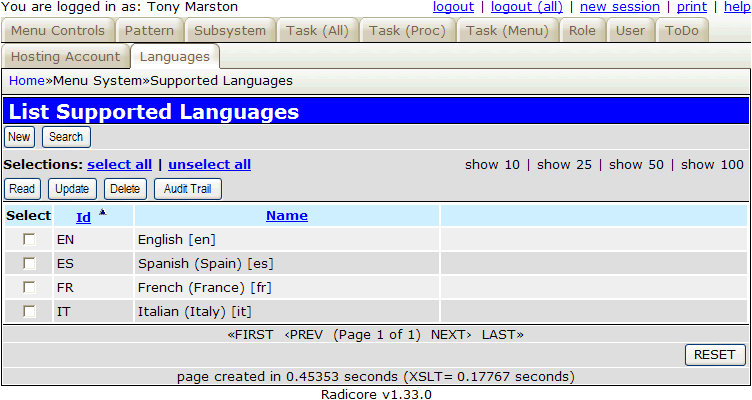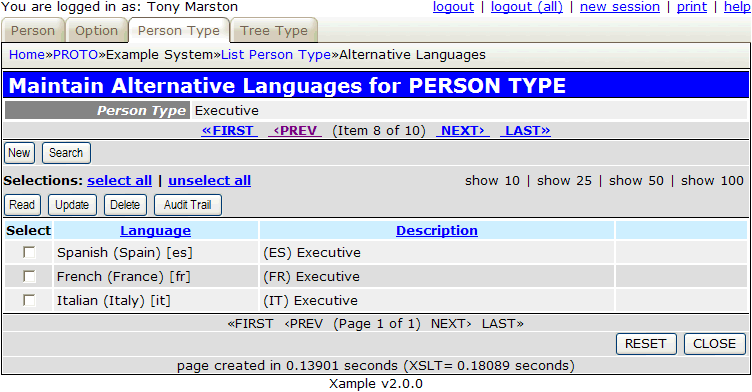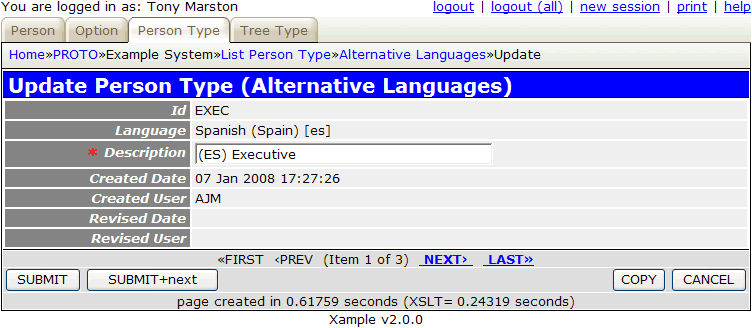1st February 2008
Internationalisation in a software application covers the ability to communicate with a user in his/her own language. It can be said to exist at the following levels:
Level 1 is supported in the Radicore framework by having the text for such things as screen titles, field labels, button labels and error messages contained in text files which are separate from the program code. Each set of files contains text in a single language and is held in a subdirectory whose name identifies that language. Each supported language therefore has a copy of these files in its own subdirectory. The framework will detect the user's preferred language, and will access the text files in the appropriate subdirectory. Please refer to Internationalisation and the Radicore Development Infrastructure (Part 1) for full details.
Level 2 is supported in the Radicore framework by maintaining translated text in separate tables within the application database. The framework will detect the user's preferred language, and will retrieve either the native text or the translated text as appropriate. The details are explained in the following sections of this document.
There are several ways in which text in language 'A' can be replaced with text language 'B'. Before a solution can be designed it is necessary to examine the range of possibilities and weigh up the pros and cons of each one.
While reviewing the possible options I made the following decisions:
It is likely that an application will not offer support for all possible languages, therefore it will be necessary to identify the subset of languages that will be supported. This can be done via the List Supported Languages task as shown in Figure 1. Note that one of these languages should also be identified on the Menu Control Data as the default language.
Figure 1 - List Supported Languages

The default language will be used for the text on the "base" table, while the others will identify the language codes that are expected to exist on the various translation tables.
It is important to note that not every text field in every database table requires multiple translations. The first step is therefore to identify those tables which contain text fields which DO require multiple translations. For each of these tables (known as "base" tables) it is then necessary to create an additional database table to hold the translations. Each of these alternative language tables should have the following characteristics:
language_id with a type of varchar(5).This should produce a database structure similar to the following:
CREATE TABLE IF NOT EXISTS `x_option` ( `option_id` varchar(8) NOT NULL default '', `option_desc` varchar(40) NOT NULL default '', `created_date` datetime NOT NULL default '2000-01-01 00:00:00', `created_user` varchar(16) NOT NULL default 'UNKNOWN', `revised_date` datetime default NULL, `revised_user` varchar(16) default NULL, PRIMARY KEY (`option_id`) ) TYPE=MyISAM;
CREATE TABLE IF NOT EXISTS `x_option_alt` ( `option_id` varchar(8) NOT NULL default '', `language_id` varchar(5) NOT NULL default '', `option_desc` varchar(40) NOT NULL default '', `created_date` datetime NOT NULL default '2000-01-01 00:00:00', `created_user` varchar(16) NOT NULL default 'UNKNOWN', `revised_date` datetime default NULL, `revised_user` varchar(16) default NULL, PRIMARY KEY (`option_id`,`language_id`) ) TYPE=MyISAM;
Using the tasks which are supplied as part of the Data Dictionary you must perform the following:
// alternative language options $this->alt_language_table = 'x_pers_type_alt'; $this->alt_language_cols = 'pers_type_desc';
// parent relationship details $this->parent_relations[] = array('parent' => 'x_pers_type', 'parent_field' => 'pers_type_desc', 'alt_language_table' => 'x_pers_type_alt', 'alt_language_cols' => 'pers_type_desc', 'fields' => array('pers_type_id' => 'pers_type_id'));
The <tablename>.class.inc file for each translation table should be amended to include the following custom method:
function _cm_getExtraData ($where, $fieldarray)
// Perform custom processing for the getExtraData method.
// $where = a string in SQL 'where' format.
// $fieldarray = the contents of $where as an array.
{
if (!array_key_exists('language_id', $this->lookup_data)) {
// get options for language_code
$array = getLanguageArray('languages');
$this->lookup_data['language_id'] = $array;
} // if
return $fieldarray;
} // _cm_getExtraData
This will load the contents of the dropdown list for the language_id field.
In order to achieve this a new task must be created. Using the Generate PHP scripts procedure take the following steps:
When this new task is run it should look something like that shown in Figure 2:
Figure 2 - Maintain Alternative Languages

When this task is run it will ensure that an entry exists on the translation table for each of the supported languages (except for the default language which already exists on the "base" table). If any entry is missing it will automatically be created with each column being filled in from the contents of the "base" table, but with a prefix which identifies the language code. This will help identify those entries which have yet to be translated.
Note that no custom code needs to be built into the LIST2 task to achieve this as the std.list2.inc file already contains the following standard code:
if (!empty($outer_data)) { $inner_data = $dbinner->getData($where); if ($dbinner->tablename == $dbouter->alt_language_table) { // ensure that default entries exist for all supported languages $inner_data = $dbinner->getLanguageEntries($inner_data, $outer_data, $dbouter->alt_language_cols); } // if } // if
In order to modify any of the text translations simply select them and press the "Update" button in the navigation bar. This will activate a task similar to the one shown in Figure 3:
Figure 3 - Update Alternative Language

Having created text in alternative languages for certain columns in certain tables, what code does the developer need to insert so that the correct translation is retrieved at runtime to match the user's preferred language? The answer is - none. Provided that $this->sql_from is empty when leaving the _cm_pre_getData() method then the _sqlForeignJoin() method will be called to construct the default values for $this->sql_select and $this->sql_from which will include JOINS to all the parent tables specified in the $parent_relations array. If it is required to add manual extensions to the $this->sql_select and $this->sql_from strings please refer to FAQ 84.
The _sqlForeignJoin() method will look for non-empty values for $alt_language strings for the current table ("base" table) as well as any parent tables and, if found, will alter the contents of the $this->sql_select and $this->sql_from strings as follows:
COALESCE((SELECT fieldname
FROM alt_language_table
WHERE alt_language_table.foreign_key=base_table.primary_key
AND alt_language_table.language_id='??')
, base_table.fieldname) AS fieldname
where language_id is taken either from the language_code field in the USER record, or from the language setting in the user's browser (whichever comes first).
Note that COALESCE(option1, option2) AS fieldname is used so that if an entry with that language_id does not exist then the text from base_table.fieldname will be used to supply the text in the default language.
fieldname already exists in $this->sql_select then it will be removed otherwise it will cause an ORA-00918: column ambiguously defined error in Oracle.fieldname exists in $this->sql_orderby and is qualified with a table name, then that table name must be removed. Sorting by base_table.fieldname will not be appropriate if the value is actually obtained from alt_language_table.fieldname.fieldname exists in $this->sql_search then it will be moved to $this->sql_having.